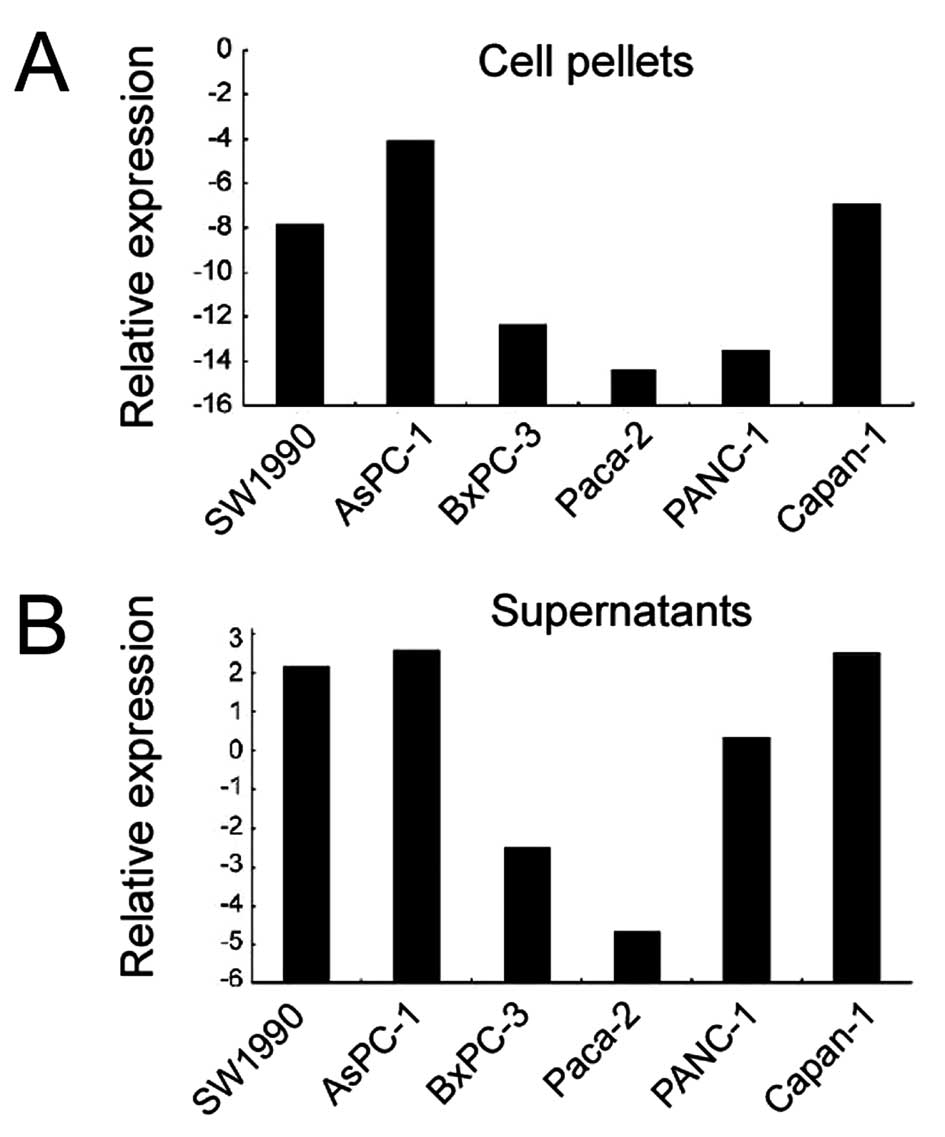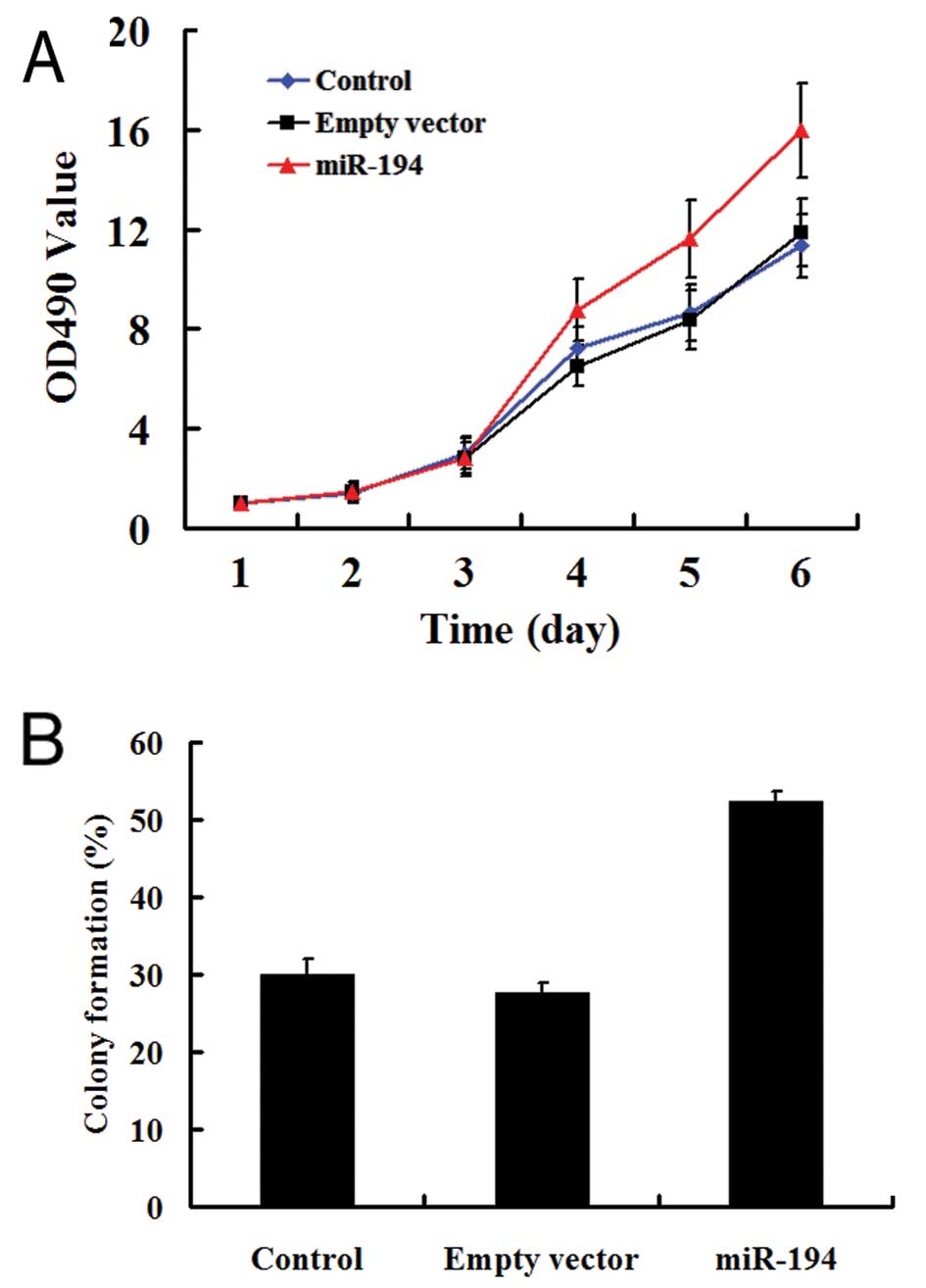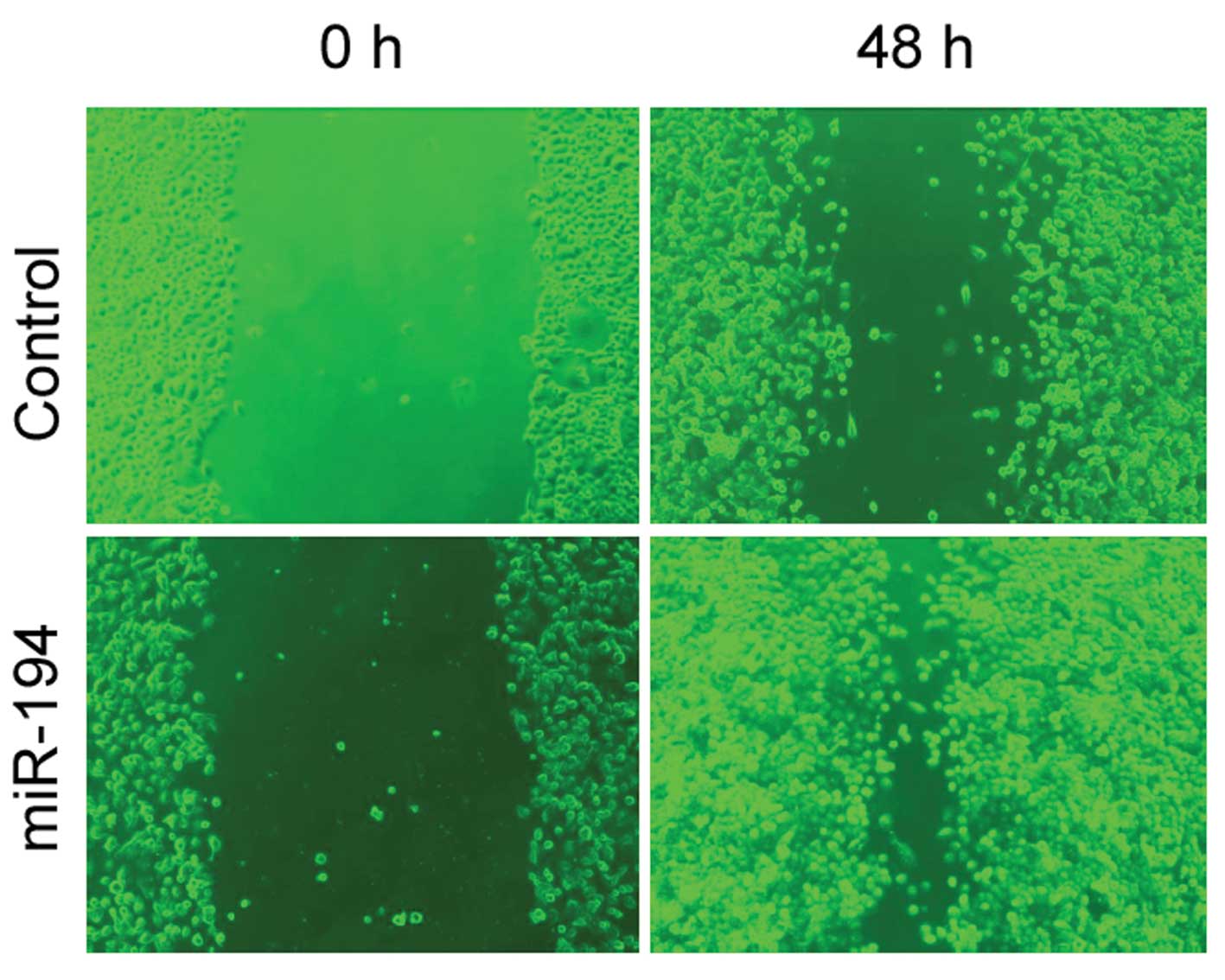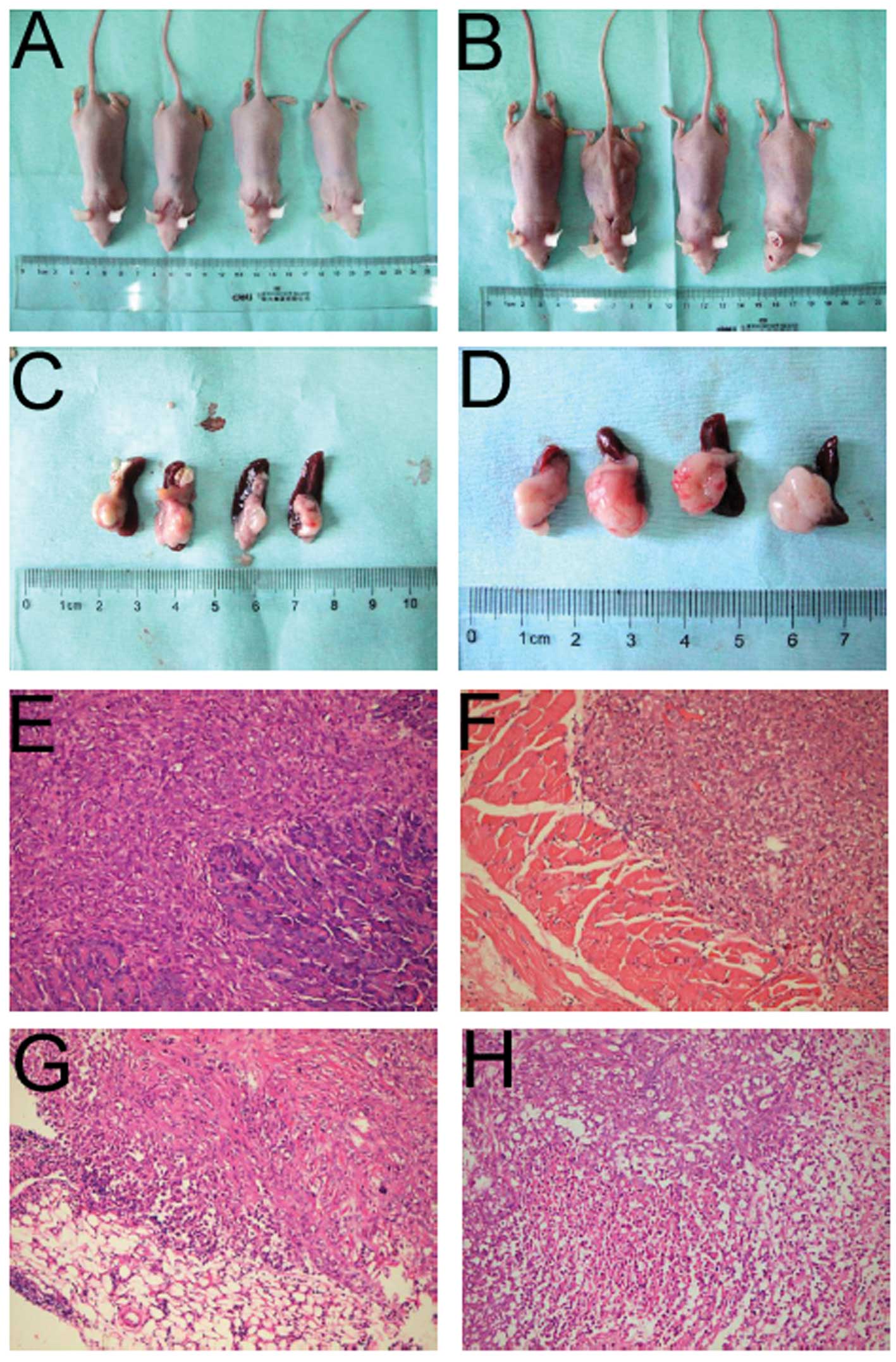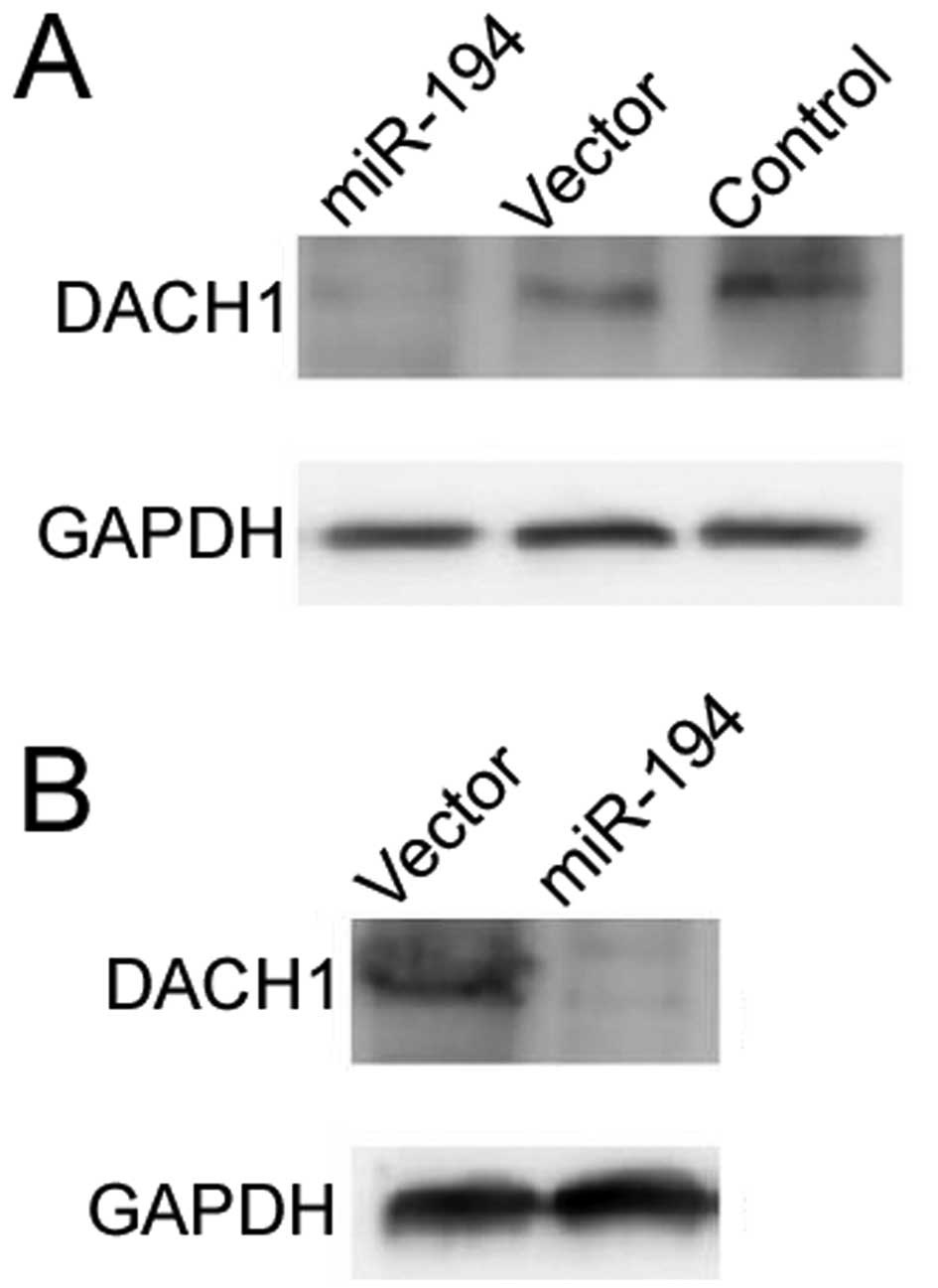Introduction
Pancreatic ductal adenocarcinoma (PDAC) ranks among
the most lethal types of human cancer, with a 5-year survival rate
of <5% and a median survival time of <6 months (1,2). Late
presentation and aggressive metastatic progression are important
factors contributing to the extremely poor prognosis of PDAC.
Several non-invasive imaging techniques such as magnetic resonance
imaging have been used to detect PDAC. However, early diagnosis of
this disease remains clinically challenging, as currently available
imaging techniques fail to reliably detect pancreatic tumors <1
cm in size (3). Therefore,
identification of novel molecular targets for early diagnosis and
therapeutic intervention is of importance for clinical management
of this malignancy.
MicroRNAs (miRNAs) are a large family of non-coding,
single-stranded RNAs of ~22 nucleotides, which negatively regulate
gene expression by binding to the 3′-untranslated region (UTR) of
target mRNAs, leading to accelerated mRNA turnover and/or
translational repression (4). In a
canonical pathway, miRNAs are expressed as primary miRNA
transcripts, which are cleaved into pre-miRNA molecules, exported
from the nucleus, and further processed by Dicer to produce mature
miRNAs. Compelling evidence indicates that miRNAs actively
participate in carcinogenesis, acting as oncogenes or tumor
suppressor genes (5); they can
simultaneously regulate a large number of target genes and affect
many aspects of tumor progression such as proliferation, migration,
invasion, epithelial-mesenchymal transition and angiogenesis
(6,7). Given that miRNAs are frequently
deregulated in cancer and can be stably detected in human plasma or
serum, circulating miRNAs are increasingly being explored as
non-invasive diagnostic biomarkers for early cancer detection
(8).
Many individual miRNAs have been implicated in the
pathogenesis of PDAC. For instance, Liffers et al (9) reported that miR-148a is downregulated
in PDACs and negatively regulates tumor cell growth and colony
formation. miR-21 was found to be required for PDAC cell
proliferation and survival, as its downregulation led to reduced
cell proliferation and increased cell death in MIA PaCa-2 PDAC
cells (10). The diagnostic values
of circulating miRNAs have been described in pancreatic cancer. Liu
et al (11) proposed that a
panel of 7 miRNAs (i.e., miR-20a, miR-21, miR-24, miR-25, miR-99a,
miR-185 and miR-191) have high sensitivity and specificity for
distinguishing pancreatic cancer from cancer-free controls and from
chronic pancreatitis. The application of miRNA profiling technology
has made great progress in developing novel biomarkers and
therapeutic targets for PDAC. By combining tissue microdissection
with global miRNA array analyses, Munding et al (12) identified miR-135b as an effective
biomarker for PDAC, which can discriminate chronic pancreatitis
from PDAC with a sensitivity and specificity of >90%.
In the present study, we also employed microarray
techniques to identify novel differentially expressed miRNAs and
tested their potential as diagnostic biomarker for PDAC.
Additionally, the biological functions of miRNAs of interest in
PDAC development and progression were investigated.
Materials and methods
Patients and samples
For miRNA profiling analysis, 9 cases of PDAC and 3
adjacent non-tumorous pancreatic tissues were obtained from 9 PDAC
patients (4 males and 5 females, aged 47–75 years) who underwent
surgical resection of tumors at the Department of Pancreatic
Surgery of Changhai Hospital (Shanghai, China). For measurement of
the expression of miRNAs of interest, 31 pairs of freshly resected
PDACs and their corresponding non-tumorous tissues were collected
from a second cohort of patients with PDAC (15 males and 16
females, aged 45–77 years, with a median age of 61 years). For
assessment of the diagnostic significance of serum miRNAs, we
enrolled an independent cohort of 70 PDAC patients, 17 age-matched
duodenal adenocarcinoma patients, and 40 age-matched healthy
controls. All PDAC patients were pathologically diagnosed by
biopsy, and those with any prior anticancer therapy were excluded
from the present study. All procedures involving humans (ref. no.
CTcp008) were approved by the Ethics Committee of the Second
Military Medical University (Shanghai, China) in accordance with
the Helsinki Declaration and written informed consent was obtained
from all patients. All animal experiments were undertaken in
accordance with the National Institutes of Health Guide for the
Care and Use of Laboratory Animals, with the approval of the
Scientific Investigation Board of the Second Military Medical
University (no. Lacp0010).
Cells and culture
Six pancreatic cancer cell lines, SW1990, BxPC-3,
MIA Paca-2, PANC-1, Capan-1 and AsPC-1, were obtained from American
Type Culture Collection (Manassas, VA, USA). SW1990, AsPC-1, BxPC-3
and PANC-1 cells were cultured in RPMI-1640 medium supplemented
with 10% fetal bovine serum (FBS) (PAA, Vienna, Austria), MIA
PaCa-2 cells in Dulbecco’s modified Eagle’s medium (DMEM)
supplemented with 10% FBS and 2.5% horse serum (PAA), and Capan-1
cells in Iscove’s modified Dulbecco’s medium (IMDM) containing 20%
FBS. All cultures were maintained at 37°C in a 5% (v/v)
CO2 humidified atmosphere.
For examination of miRNA expression and secretion,
the pancreatic cancer cells were seeded onto 6-well plates at a
density of 2×106 cells/well. After a 24-h incubation in
serum-free media, the cells and their culture supernatants were
separately collected and subjected to quantitative real-time
polymerase chain reaction (qRT-PCR) analysis.
miRNA microarray analysis
miRNA expression profile analysis was performed
using an Agilent miRNA microarray platform (Agilent, Santa Clara,
CA, USA) that can simultaneously measure 713 miRNAs (13). Total RNA was extracted from human
PDACs and adjacent normal pancreatic tissues using a mirVana PARIS
kit (AM1561; Ambion, Austin, TX, USA) according to the
manufacturer’s instructions and as previously described (14). Cy3 labeling of RNA was performed
using a miRNA labeling reagent and hybridization kit (Agilent
5190-0408; Agilent, Palo Alto, CA, USA). An Agilent microarray
scanner and Agilent feature extraction software were employed for
microarray data collection and analysis. Microarray scanning and
data acquisition were performed at the Shanghai Biochip Company
(Shanghai, China). Raw microarray data were normalized using the
variance stabilization and normalization method. A two-sample
t-test was used for the statistical analysis and a P-value <0.05
was considered statistically significant. In each group, the
proportion of samples with a detection value of 1 was required to
be >60%.
Locked nucleic acid-based in situ
hybridization (LNA-ISH)
LNA-ISH was performed using LNA™ probes against
miR-194 (Exiqon, Vedbaek, Denmark) on 5 frozen human PDAC samples
according to the manufacturer’s protocol, as previously described
(14,15).
miRNA expression detected by qRT-PCR
Total RNA was extracted from tissues or cultured
cells using the mirVana PARIS kit, as described above. Reverse
transcription reaction was carried out using a TaqMan MicroRNA
Reverse Transcription kit (Applied Biosystems, Foster City, CA,
USA). miRNA concentrations were quantified in duplicate by
real-time PCR using a human TaqMan MicroRNA Assay kit (Applied
Biosystems). Cycle threshold (Ct) values were calculated using SDS
1.4 software (Applied Biosystems). The relative expression of
miRNAs was calculated with the 2−ΔΔCt method and
normalized against U6 snRNA (16).
Plasmids and preparation of lentiviral
particles
The pGC-LV-miR-194 plasmid, which expresses
full-length human pre-miR-194 and a control empty plasmid were
purchased from Shanghai Jikai Gene Chemical Technology (Shanghai,
China). For production of lentiviral particles expressing miR-194,
293T cells were transfected with the expression vector
pGC-LV-miR-194 or control plasmid along with the packaging vectors
using Lipofectamine® 2000 (Invitrogen, Carlsbad, CA,
USA), according to the manufacturer’s instructions. The recombinant
lentiviral particles were collected and purified. The multiplicity
of infection (MOI) was determined in 293T cells. Aliquots of
lentivirus were stored at −80°C until use.
Transduction of lentiviral particles
For transduction of recombinant lentiviral
particles, PANC-1 cells were seeded onto 6-well plates at a density
of 3×105 cells/well and incubated overnight in RPMI-1640
medium with 10% FBS. Due to the low endogenous levels of miR-194,
PANC-1 cells were chosen for gain-of-function experiments. PANC-1
cells were then transduced with lentiviral particles at an MOI of
20 in the presence of polybrene (6 μg/ml). Cells were refreshed
with culture medium 24 h later. Since the pGC-LV vector expresses
green fluorescent protein (GFP), GFP-positive cells were sorted by
flow cytometry and expanded. qRT-PCR analysis was carried out to
confirm the overexpression of miR-194 in the transduced PANC-1
cells.
MTT assay
Non-transduced and transduced PANC-1 cells were
plated in triplicate in 96-well microplates at a density of
1.5×103 cells/well. Cell viability was assessed once
daily for 6 consecutive days after seeding, using the
3-(4,5-dimethylthiazol-2-yl)-2,5-diphenyltetrazolium bromide (MTT)
assay. MTT solution (5 g/l; Sigma, St. Louis, MO, USA) was added to
the cell cultures and incubated at 37°C for 4 h. After removal of
the MTT solution, dimethyl sulfoxide solution was added to dissolve
the formazan crystals. The absorbance was measured at a wavelength
of 490 nm. The experiments were repeated 3 times. Growth curves
were constructed by plotting the absorbance values vs. time.
Colony formation assay
Non-transduced and transduced PANC-1 cells were
plated onto 6-well plates at a density of 4,200 cells/well and
incubated for 10 days at 37°C. Cells were washed, fixed in 10%
methanol for 15 min and stained in Giemsa for 10–30 min. Colonies
consisting of >50 cells were counted under a low-magnification
microscope. The experiments were repeated 3 times. Colony formation
rate was calculated as colony number/total cells seeded × 100%.
In vitro wound healing assay
Transduced PANC-1 cell migration was determined
using an in vitro wound healing assay. Briefly, cells were
seeded onto 6-well plates at a density of 5×105
cells/well. After incubation for 48 h, an open area or ‘scratch’
was produced in the cell monolayers using a 100 ml pipette tip. The
cell cultures were washed several times to remove the displaced
cells in the open area and then incubated for 48 h. The extent of
wound closure was examined by phase-contrast microscopy.
Tumorigenicity in nude mice
Nude mice were purchased from the Experimental
Animal Center of Shanghai (Shanghai, China) and randomly divided
into 2 groups (n=4). To establish orthotopic pancreatic tumors,
animals were anesthetized and the pancreas was exposed via an
abdominal incision. The mice were injected into the pancreas at a
single site with 5×107 miRNA-194-overexpressing or empty
vector-transduced PANC-1 cells. After tumor cell implantation, the
pancreas was carefully returned to the peritoneal cavity and the
abdomen was closed. All animals were monitored for 50 days for
tumor formation and then sacrificed when the tumor diameter reached
~1.5 cm. The tumors were resected and tumor volumes were determined
using calipers. One part of the tumor specimens was processed for
histological analysis and the other was snap-frozen and stored at
−80°C for western blot analysis. All animal experiments were
undertaken in accordance with the National Institutes of Health
Guide for the Care and Use of Laboratory Animals, with the approval
of the Scientific Investigation Board of the Second Military
Medical University [no: (2008) CTcp008].
Protein extraction and western blot
analysis
Primary antibodies against DACH1 (1:1,000) and
glyceraldehyde 3-phosphate dehydrogenase (GAPDH) (1:3,000; Santa
Cruz Biotechnology, Inc., Santa Cruz, CA, USA) were used. PANC-1
cells and xenograft tumors were lysed in a 10 mM Tris-buffer (pH
7.4) containing 1% sodium dodecyl sulfate (SDS) and complete
protease inhibitors (Roche). Samples of the lysates (80 μg) were
separated by SDS-polyacrylamide gel electrophoresis, transferred to
polyvinylidene fluoride membranes (Millipore, Bedford, MA, USA),
and probed with the primary antibodies. After the incubation with
horseradish peroxidase-conjugated secondary antibody, the blots
were visualized with enhanced chemiluminescence detection reagents
(sc-2048) (both from Santa Cruz Biotechnology, Inc.). The intensity
of each band was measured using a Fluor-S MultiImager and Quantity
One software (Bio-Rad, Hercules, CA, USA).
Statistical analysis
Data are presented as means ± SD. All statistical
calculations were carried out using SPSS 11.7 software (SPSS,
Chicago, IL, USA). The Mann-Whitney U test or Student’s t-test was
used to compare continuous variables between 2 groups. The
difference among the means of multiple groups was analyzed by
one-way analysis of variance followed by the Tukey’s test. Receiver
operating characteristics (ROC) curves were established to evaluate
the diagnostic potential of miR-194. A P-value <0.05 was
considered to indicate a statistically significant result.
Results
Upregulation of miR-194 in PDAC
As we previously described (14), miRNA profiling analysis revealed
that among the 713 miRNAs tested, 8 (miR-194*,
miR-192*, miR-602, miR-801, miR-194, miR-192, miR-212
and miR-34a*) showed upregulated expression and 8
(miR-923, miR-139-3p, miR-513a-5p, miR-630, miR-30c-1*,
miR-887, miR-508-5p and miR-516a-5p) showed downregulated
expression in PDAC pools, with a cut-off value of 1.15-fold change.
miR-194 showed the greatest changes in expression levels among
these differentially expressed miRNAs and thus was further explored
for its diagnostic and biological significance in PDAC.
To confirm the microarray results, tissue miR-194
expression was examined by LNA-ISH. Positive cytoplasmic staining
for miR-192 was evident in tumor cells but was rarely noted in the
stromal cells of the PDAC specimens (Fig. 1A). However, no miR-192 positivity
was found in the adjacent normal pancreatic tissues (Fig. 1B).
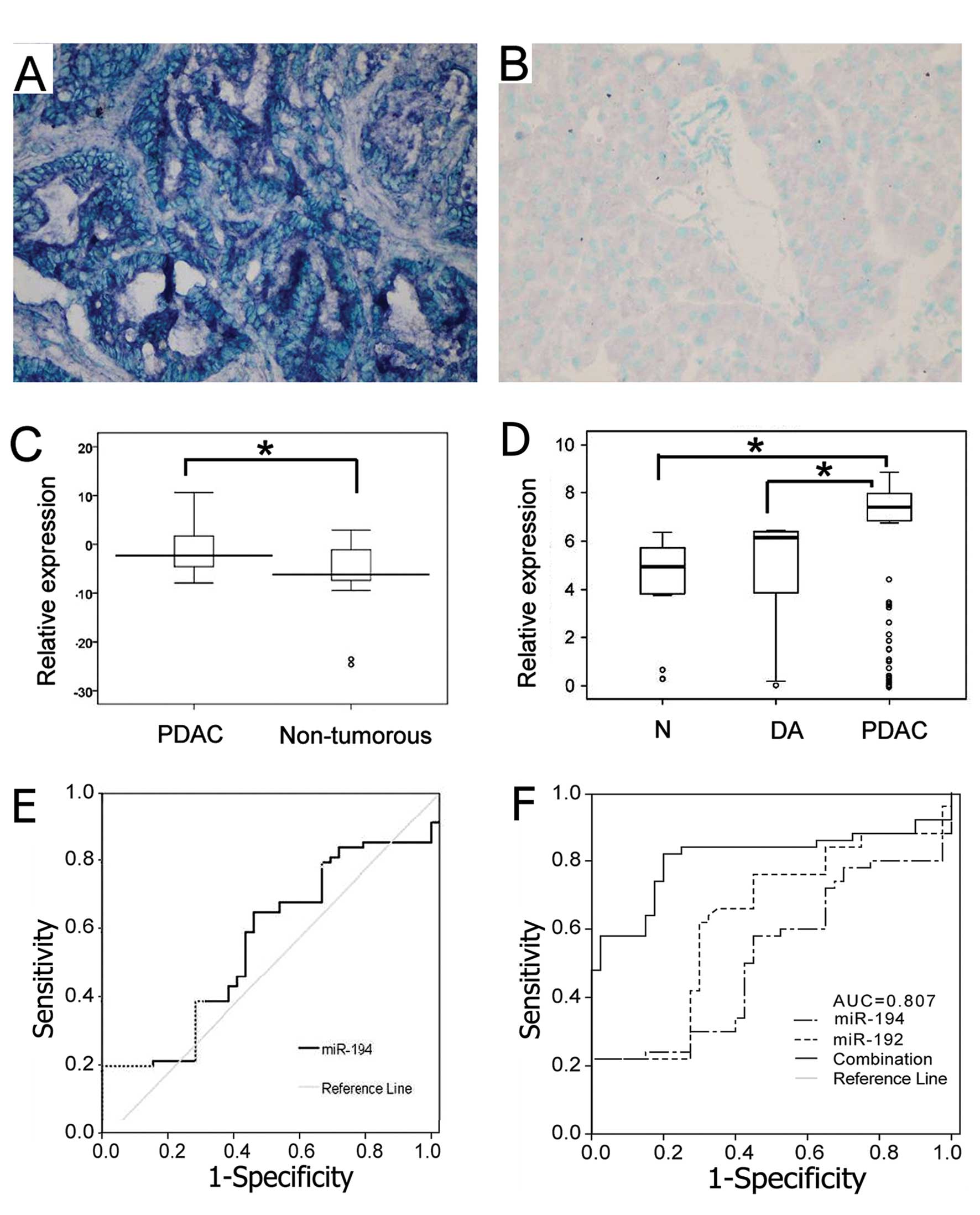 | Figure 1Expression and diagnostic significance
of miR-194 in PDAC. Positive cytoplasmic staining for miR-194 was
noted in (A) human PDAC tissues but not in (B) adjacent normal
pancreatic tissues by LNA-ISH. Original magnification, ×400. (C)
qRT-PCR analysis of miR-194 levels in 31 pairs of PDACs and
adjacent non-tumorous tissues. (D) qRT-PCR analysis of serum
miR-194 levels in 70 PDAC patients, 17 age-matched duodenal
adenocarcinoma (DA) patients and 40 age-matched normal (N)
controls. The relative miRNA expression level was determined by
normalizing against U6 snRNA. The thick horizontal line indicates
the mean. *P<0.05. (E) ROC curve analysis for
discrimination between 70 PDAC patients and 40 healthy controls by
serum miR-194. (F) AUCs for miR-192, miR-194 and combination of the
2 were 0.641, 0.571 and 0.807, respectively. The sensitivity and
specificity for miR-192, miR-194 and a combination of the 2 were
76.0 and 55.0%, 58.0 and 55.0%, and 84.0 and 75.0%, respectively.
PDAC, pancreatic ductal adenocarcinoma; LNA-ISH, locked nucleic
acid-based in situ hybridization; qRT-PCR, quantitative
real-time polymerase chain reaction; ROC, receiver operating
characteristics; AUCs, area under the curves. |
To confirm the microarray results, miR-194
expression in 31 pairs of PDACs and adjacent normal tissues was
examined by qRT-PCR analysis. As shown in Fig. 1C, miR-194 expression was
significantly (P<0.05) elevated in PDACs compared to adjacent
normal tissues.
Diagnostic significance of serum miR-194
in PDAC
qRT-PCR analysis revealed that PDAC patients had
>3-fold greater concentrations of serum miR-194 than duodenal
adenocarcinoma patients or healthy controls (P<0.05 for each
comparison; Fig. 1D). However, no
significant difference in the serum miR-194 level was observed
between duodenal adenocarcinoma patients and healthy controls.
To assess the diagnostic significance of serum
miR-194 in differentiating between PDAC patients and healthy
individuals, ROC curves were constructed (Fig. 1E). The area under the curve (AUC)
was 0.571 [95% confidence interval (CI), 0.462–0.681]. With an
optimal cut-point, the sensitivity and specificity was calculated
as 54.3 and 57.5%, respectively.
The possibility of using miR-192 and miR-194 as
biomarkers for PDAC diagnosis was examined further. The ROC curves
of the miRNAs are presented in Fig.
1F. The area under curve (AUC) was 0.627 (95% CI, 0.508–0.745)
for miR-192 and 0.517 (95% CI, 0.396–0.638) for miR-194. Analysis
of miR-192 and miR-194 together using a discriminant analysis model
showed a combined AUC of 0.807 (95% CI, 0.711–0.903). By means of
optimal cut-point determination, the sensitivity and specificity
were found to be 76.0 and 55.0% for miR-192, 58.0 and 55.0% for
miR-194, and 84.0 and 75.0% for the combination of the 2,
respectively (Fig. 1F).
Discriminant analysis showed that a combination of miR-192 and
miR-194 may be a useful biomarker (P<0.01) for PDAC
diagnosis.
Effects of miR-194 overexpression on the
proliferation, colony formation and migration of PANC-1 cells
The relative expression of miR-194 in a panel of
pancreatic cancer cell lines was measured by qRT-PCR. We found that
miR-194 was the most abundant in AsPC-1 cells, followed by Capan-1,
SW1990, BxPC-3, PANC-1 and MIA PaCa-2 cells (Fig. 2A). Similar findings were noted in
their culture supernatants (Fig.
2B). Due to the low expression of miR-194, PANC-1 cells were
chosen for gain-of-function studies. Lentiviral delivery of miR-194
resulted in a significant increase of miR-194 expression in PANC-1
cells, as compared to control cells transduced with empty
lentiviral particles (P<0.05; data not shown).
The MTT assay revealed that miR-194-overexpressing
PANC-1 cells had a significant increase in proliferation 72 h after
seeding, as compared to empty lentiviral particle-transduced cells
(P<0.05; Fig. 3A). The colony
formation assay showed that miR-194-overexpressing PANC-1 cells
showed a significantly higher colony formation rate than empty
vector-transduced cells (52.3±1.3 vs. 27.7±1.3%, P<0.01;
Fig. 3B). In vitro wound
healing assay further showed that enforced expression of miR-194
markedly promoted the migration of PANC-1 cells, as evidenced by
acceleration of wound closure (Fig.
4).
Effects of miR-194 overexpression on
tumorigenicity of PANC-1 cells
Next, we examined the effects of miR-194
overexpression on tumorigenicity of PANC-1 cells, using an
orthotopic xenograft model. At 50 days after cell implantation,
tumor formation was observed in each animal. Of note,
miR-194-overexpressing PANC-1 cells formed significantly larger
tumors in nude mice than empty vector-transduced PANC-1 cells
(0.4625±0.127 cm3 vs. 0.196±0.083 cm3,
P<0.05; Fig. 5A and B).
Macroscopically, mock-transduced PANC-1 cells dominantly formed
small round tumors circumscribed with a thin capsule in nude mice
(Fig. 5C). In contrast, xenograft
tumors derived from miR-194-overexpressing cells appeared nodular
and highly vascularized (Fig. 5D).
Histopathologically, miR-194 xenograft tumors comprised a large
number of proliferating neoplastic cells and small blood vessels,
with local invasion of adjacent muscle, fat and spleen tissues
(Fig. 5E–H).
Western blot analysis demonstrated that the DACH1
protein level was profoundly reduced in miR-194 xenograft tumors
compared to control tumors (Fig.
6A). In vitro studies confirmed that
miR-194-overexpressing PANC-1 cells showed lower DACH1 protein
levels than mock-transduced PANC-1 cells (Fig. 6B).
Discussion
Increasing evidence suggests that aberrant
expression of miRNAs represents a pathogenic hallmark of cancer
(5–7). A large number of miRNAs such as
miR-148a, miR-217, miR-196a (17),
miR-221 (18) and miR-211 (19) are deregulated in pancreatic cancer
and show diagnostic and prognostic relevance in this disease. In
the present study, we employed miRNA microarrays to identify novel
differentially expressed miRNAs, which may have the potential to be
useful biomarkers for cancer detection. Our results revealed that
there were 16 miRNAs with ≥1.15-fold expression changes (8 genes
overexpressed and 8 underexpressed) in surgically resected PDACs
relative to adjacent non-tumorous pancreatic tissues. miR-194
showed the greatest changes in expression levels among these miRNAs
and thus was further explored for its diagnostic and biological
significance in PDAC. qRT-PCR analysis confirmed the microarray
findings and revealed that miR-194 was significantly upregulated in
PDACs compared to adjacent normal tissues. Similarly, Mees et
al (20) reported that
upregulation of miR-194 correlates with reduced expression of tumor
suppressor EP300 in metastatic PDAC cells. These findings suggest
that miR-194 may play a favorable role in PDAC progression.
It has been suggested that some cellular miRNAs can
be encapsulated in exosome-like vesicles and released into
extracellular environment (13). In
supporting this view, our data revealed that miR-194 can be
detected in the culture supernatants of a panel of pancreatic
cancer cell lines. The mechanism of miRNA release is still not
completely understood. A recent study suggested that miRNA release
may be mediated through a ceramide-dependent secretory machinery
(21). miRNAs are present in human
plasma or serum in a markedly stable form that is protected from
endogenous RNase activity (22).
Therefore, circulating miRNAs have the potential as non-invasive
biomarkers for cancer detection. Indeed, circulating miR-378 and
miR-451 in serum have been proposed as potential biomarkers for
renal cell carcinoma (23).
Similarly, miR-221 (18) and
miR-18a (18) in the plasma have
shown diagnostic significance in pancreatic cancer. Our present
data revealed that serum miR-194 concentrations were significantly
higher in PDAC patients than in duodenal adenocarcinoma patients
and healthy controls. However, serum miR-194 levels may
discriminate PDAC patients from healthy individuals with a
sensitivity and specificity of only <60%. The discriminating
power indicated by the AUC value (0.571) was markedly lower than
the expectations of clinical utility. These findings suggest that
serum miR-194 alone may not be suitable as a diagnostic marker for
PDAC. Combined analysis of the 3 groups yielded a sensitivity of
84.0 and a specificity of 75.0% for the combined detection of
miR-192 and miR-194 in the diagnosis of PDAC. This indicates that
single miRNA may not be a satisfactory tumor marker, but the
combined determination of multiple miRNAs can have a high
sensitivity and specificity. Wang et al (24) documented that the combination of the
4 miRNAs (miR-21, miR-210, miR-155 and miR-196a) raises the AUC
value from 0.62 to 0.69 ranging for each individual miRNA to 0.82
for pancreatic cancer detection. Therefore, the combination of
serum miR-194 with other miRNAs or protein biomarkers warrants
further study.
Several previous studies suggested that miR-194
often acts as a suppressor of tumor progression and metastasis
(25,26). For instance, Khella et al
(25) reported that miR-194 is
downregulated in metastatic renal cell carcinoma and restoration of
its expression decreases cell migration and invasion in renal cell
carcinoma cell line models. Similarly, the overexpression of
miR-194 in liver mesenchymal-like cancer cells was found to reverse
the epithelial-mesenchymal transition and cancer cell invasion and
migration (26). However, Iizuka
et al (27) showed that
miR-194 is upregulated in human breast cancer cell lines and its
depletion leads to significant suppression of cell proliferation.
Sundaram et al (28)
reported that miR-194 overexpression promotes tumor angiogenesis in
colon cancer. Therefore, the overall contribution of miR-194 to
tumor growth and progression is cellular context dependent. Our
results showed that enforced expression of miR-194 promoted cell
proliferation, colony formation and migration in PANC-1 cells. The
growth-promoting effects of miR-194 overexpression were also
observed in the orthotopic pancreatic tumor model. DACH1 functions
as a tumor suppressor in several types of cancer, such as breast
cancer, glioma and prostate cancer (29–31).
Notably, we found that the protein expression of DACH1 was markedly
reduced in miR-194-overexpressing PANC-1 cells and xenograft
tumors, which provides an explanation for the tumorigenic role of
miR-194 in PDAC. Taken together, these findings indicate that
miR-194 acts as an oncogene in pancreatic cancer, thus representing
a potential therapy target for this disease. However, the exact
molecular mechanisms underlying the effects of miR-194 on
pancreatic cancer cells needs further elucidation. Additionally,
loss-of-function studies are required to complement the results of
gain-of-function studies and to further confirm the oncogenic role
of miR-194 in PDAC.
In conclusion, miR-194 is upregulated in cancer
tissue and serum of patients with PDAC, and serum miR-194 shows a
limited capacity for discriminating between PDAC cancer patients
and healthy individuals. Combined detection of serum miR-192 and
miR-194 level may serve as a sensitive diagnostic biomarker for
PDAC. Enforced expression of miR-194 facilitates tumor growth and
progression in cell and mouse models of PDAC, possibly through
downregulation of the tumor suppressor DACH1. These results
facilitate our understanding of the pathogenesis of PDAC and
suggest miR-194 as a promising therapeutic target for this
disease.
Acknowledgements
This study was supported by the National Key Project
of Scientific and Technical Supporting Programs of China (no.
2006BAI02A14), the National Natural Science Foundation of China
(nos. 30770996 and 81172310) to M.H. Zhu; and the ‘085’ first-class
discipline construction of science and technology innovation in
Shanghai University of Traditional Chinese Medicine (no. 085ZY1220)
to S.H. Zhang.
References
|
1
|
Jemal A, Siegel R, Xu J and Ward E: Cancer
statistics, 2010. CA Cancer J Clin. 60:277–300. 2010. View Article : Google Scholar
|
|
2
|
Li D, Xie K, Wolff R and Abbruzzese JL:
Pancreatic cancer. Lancet. 363:1049–1057. 2004. View Article : Google Scholar
|
|
3
|
Brand RE and Matamoros A: Imaging
techniques in the evaluation of adenocarcinoma of the pancreas. Dig
Dis. 16:242–252. 1998. View Article : Google Scholar : PubMed/NCBI
|
|
4
|
Yates LA, Norbury CJ and Gilbert RJ: The
long and short of microRNA. Cell. 153:516–519. 2013. View Article : Google Scholar : PubMed/NCBI
|
|
5
|
Fabbri M: MicroRNAs and cancer: towards a
personalized medicine. Curr Mol Med. 13:751–756. 2013. View Article : Google Scholar : PubMed/NCBI
|
|
6
|
Ahmed FE: Role of miRNA in carcinogenesis
and biomarker selection: a methodological view. Expert Rev Mol
Diagn. 7:569–603. 2007. View Article : Google Scholar : PubMed/NCBI
|
|
7
|
Cowland JB, Hother C and Grønbaek K:
MicroRNAs and cancer. APMIS. 115:1090–1106. 2007. View Article : Google Scholar
|
|
8
|
Madhavan D, Cuk K, Burwinkel B and Yang R:
Cancer diagnosis and prognosis decoded by blood-based circulating
microRNA signatures. Front Genet. 4:1162013. View Article : Google Scholar : PubMed/NCBI
|
|
9
|
Liffers ST, Munding JB, Vogt M, et al:
MicroRNA-148a is down-regulated in human pancreatic ductal
adenocarcinomas and regulates cell survival by targeting
CDC25B. Lab Invest. 91:1472–1479. 2011. View Article : Google Scholar : PubMed/NCBI
|
|
10
|
Bhatti I, Lee A, James V, et al: Knockdown
of microRNA-21 inhibits proliferation and increases cell death by
targeting programmed cell death 4 (PDCD4) in pancreatic ductal
adenocarcinoma. J Gastrointest Surg. 15:199–208. 2011. View Article : Google Scholar : PubMed/NCBI
|
|
11
|
Liu R, Chen X, Du Y, et al: Serum microRNA
expression profile as a biomarker in the diagnosis and prognosis of
pancreatic cancer. Clin Chem. 58:610–618. 2012. View Article : Google Scholar : PubMed/NCBI
|
|
12
|
Munding JB, Adai AT, Maghnouj A, et al:
Global microRNA expression profiling of microdissected tissues
identifies miR-135b as a novel biomarker for pancreatic ductal
adenocarcinoma. Int J Cancer. 131:E86–E95. 2012. View Article : Google Scholar
|
|
13
|
Ekström K, Bossios A, Sjöstrand M, Lee JJ
and Lötvall JO: Exosome-mediated transfer of mRNAs and microRNAs is
a novel mechanism of genetic exchange between cells. Nat Cell Biol.
9:654–659. 2007.PubMed/NCBI
|
|
14
|
Zhao C, Zhang J, Zhang S, et al:
Diagnostic and biological significance of microRNA-192 in
pancreatic ductal adenocarcinoma. Oncol Rep. 30:276–284.
2013.PubMed/NCBI
|
|
15
|
Rabinowits G, Gerçel-Taylor C, Day JM,
Taylor DD and Kloecker GH: Exosomal microRNA: a diagnostic marker
for lung cancer. Clin Lung Cancer. 10:42–46. 2009. View Article : Google Scholar : PubMed/NCBI
|
|
16
|
Livak KJ and Schmittgen TD: Analysis of
relative gene expression data using real-time quantitative PCR and
the 2−ΔΔCT method. Methods.
25:402–408. 2001. View Article : Google Scholar : PubMed/NCBI
|
|
17
|
Xue Y, Abou Tayoun AN, Abo KM, et al:
MicroRNAs as diagnostic markers for pancreatic ductal
adenocarcinoma and its precursor, pancreatic intraepithelial
neoplasm. Cancer Genet. 206:217–221. 2013. View Article : Google Scholar : PubMed/NCBI
|
|
18
|
Kawaguchi T, Komatsu S, Ichikawa D, et al:
Clinical impact of circulating miR-221 in plasma of patients with
pancreatic cancer. Br J Cancer. 108:361–369. 2013. View Article : Google Scholar : PubMed/NCBI
|
|
19
|
Giovannetti E, van der Velde A, Funel N,
et al: High-throughput microRNA (miRNAs) arrays unravel the
prognostic role of miR-211 in pancreatic cancer. PLoS One.
7:e491452012. View Article : Google Scholar : PubMed/NCBI
|
|
20
|
Mees ST, Mardin WA, Wendel C, et al: EP300
- a miRNA-regulated metastasis suppressor gene in ductal
adenocarcinomas of the pancreas. Int J Cancer. 126:114–124. 2010.
View Article : Google Scholar : PubMed/NCBI
|
|
21
|
Kosaka N, Iguchi H, Yoshioka Y, Takeshita
F, Matsuki Y and Ochiya T: Secretory mechanisms and intercellular
transfer of microRNAs in living cells. J Biol Chem.
285:17442–17452. 2010. View Article : Google Scholar : PubMed/NCBI
|
|
22
|
Mitchell PS, Parkin RK, Kroh EM, et al:
Circulating microRNAs as stable blood-based markers for cancer
detection. Proc Natl Acad Sci USA. 105:10513–10518. 2008.
View Article : Google Scholar : PubMed/NCBI
|
|
23
|
Redova M, Poprach A, Nekvindova J, et al:
Circulating miR-378 and miR-451 in serum are potential biomarkers
for renal cell carcinoma. J Transl Med. 10:552012. View Article : Google Scholar : PubMed/NCBI
|
|
24
|
Wang J, Chen J, Chang P, et al: MicroRNAs
in plasma of pancreatic ductal adenocarcinoma patients as novel
blood-based biomarkers of disease. Cancer Prev Res. 2:807–813.
2009. View Article : Google Scholar : PubMed/NCBI
|
|
25
|
Khella HW, Bakhet M, Allo G, et al:
miR-192, miR-194 and miR-215: a convergent microRNA network
suppressing tumor progression in renal cell carcinoma.
Carcinogenesis. 34:2231–2239. 2013. View Article : Google Scholar : PubMed/NCBI
|
|
26
|
Meng Z, Fu X, Chen X, et al: miR-194 is a
marker of hepatic epithelial cells and suppresses metastasis of
liver cancer cells in mice. Hepatology. 52:2148–2157. 2010.
View Article : Google Scholar : PubMed/NCBI
|
|
27
|
Iizuka D, Imaoka T, Nishimura M, Kawai H,
Suzuki F and Shimada Y: Aberrant microRNA expression in
radiation-induced rat mammary cancer: the potential role of miR-194
overexpression in cancer cell proliferation. Radiat Res.
179:151–159. 2013. View
Article : Google Scholar : PubMed/NCBI
|
|
28
|
Sundaram P, Hultine S, Smith LM, et al:
p53-responsive miR-194 inhibits thrombospondin-1 and promotes
angiogenesis in colon cancers. Cancer Res. 71:7490–7501. 2011.
View Article : Google Scholar : PubMed/NCBI
|
|
29
|
Popov VM, Zhou J, Shirley LA, et al: The
cell fate determination factor DACH1 is expressed in estrogen
receptor-α-positive breast cancer and represses estrogen receptor-α
signaling. Cancer Res. 69:5752–5760. 2009.PubMed/NCBI
|
|
30
|
Watanabe A, Ogiwara H, Ehata S, et al:
Homozygously deleted gene DACH1 regulates tumor-initiating activity
of glioma cells. Proc Natl Acad Sci USA. 108:12384–12389. 2011.
View Article : Google Scholar : PubMed/NCBI
|
|
31
|
Wu K, Katiyar S, Witkiewicz A, et al: The
cell fate determination factor dachshund inhibits androgen receptor
signaling and prostate cancer cellular growth. Cancer Res.
69:3347–3355. 2009. View Article : Google Scholar : PubMed/NCBI
|
















